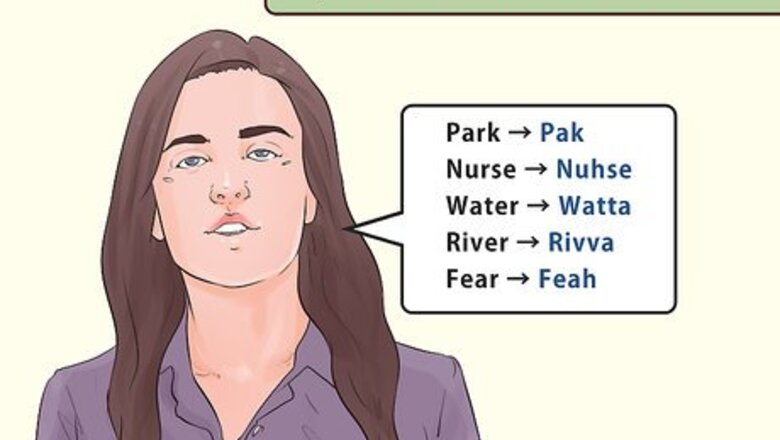
views
Note: This is an exaggerated tutorial meant for actors or performers, and can (and should) be appropriately toned down if you want a less "out there" accent.
Learning the Crucial Accent and Sounds
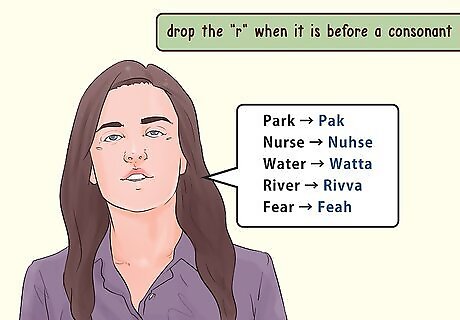
Only pronounce your "r" sounds if they are before a vowel. The dropped "r" is a classic New York sound, though it is actually going out of style. The tricky part is to remember when to subtly drop the "r." It only disappears when it is before a consonant, though the disappearance is slight -- listening to native speakers will help you find the sweet spot. So, for example: Park → "Pak." Nurse → "Nuhse." Water → "Watta" River → "Rivva" Fear → "Feah" Note, however, that some New Yorkers also add "r"s where they aren't needed, like "idea-r" or "law-r and order." These are generally colloquial and common in older speakers.
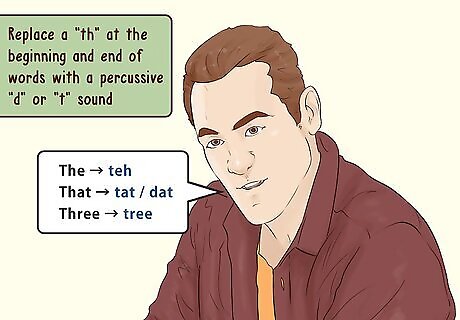
Replace a "th" at the beginning and end of words with a percussive "d" or "t" sound. This is found in the cliched New York accent expression "toity-toid street" ("33rd Street"). But it is not always so cliche -- dropping the softer, whispery "thhhh" sound for a harder "ddd" or "tttt" sound is very New York. The → "teh" That → "tat" or "dat" Three → "tree" When making "d" or "t" sounds, place your tongue against the back of your bottom teeth. Note the subtle difference.
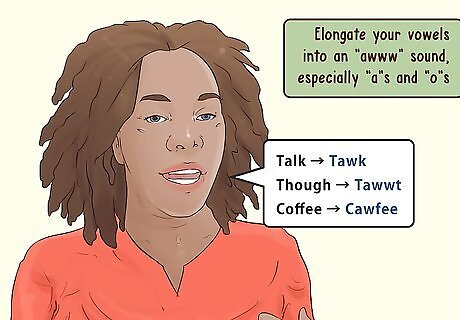
Elongate your vowels into an "awww" sound, especially "a"s and "o"s. Many of the words that have the "o" sound (like in coffee) are pronounced with an "aw" sound. So the word dog, for example, would sound like "dawg", and "coffee" would sound like "cawfee." Talk → "Tawk" Thought → "Tawwt" The short "o" sound is pretty rare in New York English. Words which include the long "i" in the middle, like "liar", use a very similar "aw" sound, so "liar" should sound almost like "lawyer"
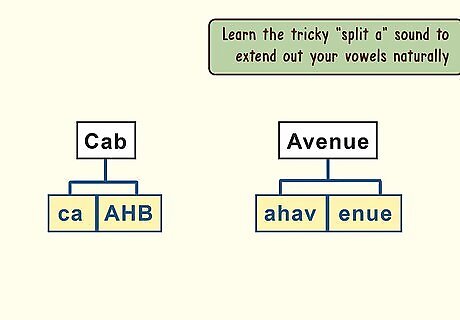
Learn the tricky "split a" sound to extend out your vowels naturally. This is a tricky one, because it requires turning one syllable into two. Some linguists actually believe it is near impossible for outsiders to learn, but you can pick it up with a bit of practice. Check out the following examples and see if they make sense, trying to get through the first syllable quickly and sliding it naturally into the next. Cab → "ca-AHB" Avenue → "ahav-enue."
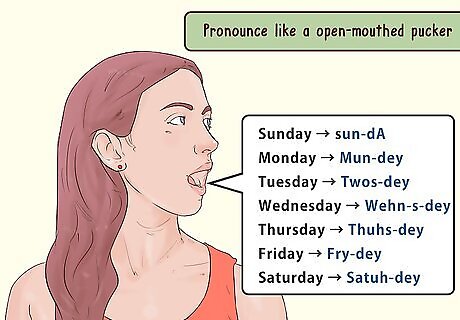
Pronounce New York English as if projecting forward in front of the mouth, almost like an open-mouthed pucker. Furthermore, most New Yorkers get their words out quickly, speaking with a pace just a bit faster than the average American. Test out a few words, phonetically spelled out for you, to get used to the accent before diving in. The capitalized letters are for emphasis. Sunday → "sun-dA" Monday → "Mun-dey" Tuesday → "Twos-dey" Wednesday → "Wehn-s-dey" Thursday → "Thuhs-dey" (err being kind of rolled r) Friday → "Fry-dey" Saturday → "Satuh-dey"
Committing to a Stronger Accent
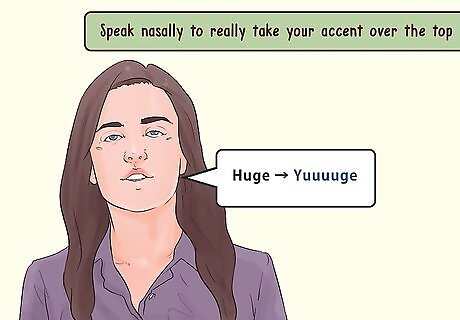
Speak nasally, with your throat feeling almost constricted, to really take your accent over the top. Bernie Sanders, Fran Drescher, and Jerry Seinfeld have all made this accent pretty recognizable, even if it is considered a bit over the top for every day speech. But if you're on stage, on screen, or just hamming it up, focus on breathing through your nose. Huge → "Yuuuuge."
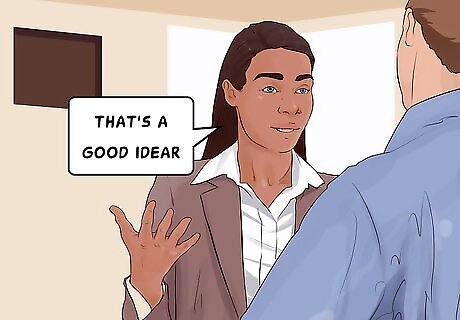
Pick up the "attitude" in your speech rhythms. Speaking like a New Yorker is less about what you say, and more about how you say it. New Yorkers are known for being direct, opinionated and confident. They are also known for talking a lot, and talking loudly. Speak quickly and succinctly. Use loud, expressive tones when speaking. Really draw out those vowels for emphasis. Throw an extra "r" at the end of words that end in vowels, like "that's a good idear."
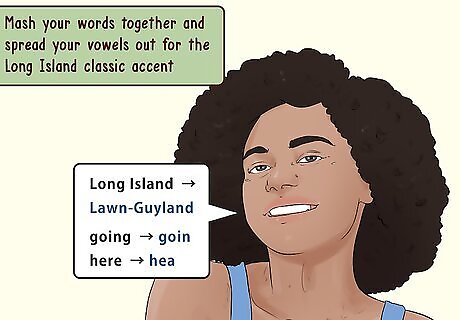
Mash your words together and spread your vowels out for the Long Island classic accent. The best way to practice is the word Long Island itself, pronounced by residents as "Lawn-Guyland") Really take your time with the vowels, stretching them out for a nice long time. The "g" at the end of "-ing" isn't pronounced either. So "going" is pronounced "goin'" and "here" sounds like "hea".
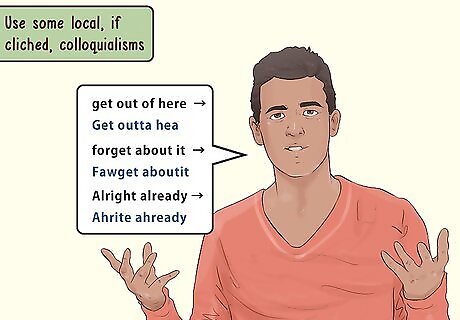
Use some local, if cliched, colloquialisms. The following expressions aren't really used so much anymore, but they're still stereotypes. They will instantly place your listener into the NYC mindset, even if that mindset is about 15 years old by now. Typical expressions Noo Yawkez use include "Get outta hea", "Fawget aboutit" & "Ahrite ahready" Say "hey", instead of "hi" or "hello" and say it quickly. Make the classic "you guys" into the NYC plural "yous guys."

Listen to native New Yorkers, online or in person, to get the subtle range of different accents. It is often a deep sounding voice, and words are spoken kind of in a relaxed way. Since New York was at one point very Italian, Staten Island and Brooklyn in particular (Staten Island is still 44% Italian, the highest percentage of any county in the country), people of Italian descent that live in the areas tend to have a little bit of Italian accent mixed in. So if you've ever heard, have or done an Italian accent, it may be a little bit easier to do a NY accent. Think of Sylvester Stallone. Now think of Danny DeVito. Both have similar accents, but also plenty of uniqueness. Your own accent can be similarly unique, as long as you follow the basic rules above. Check out this list of free files containing examples of different NYC accents to help practice.












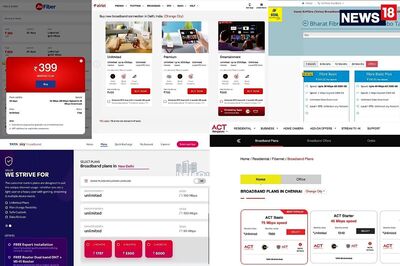


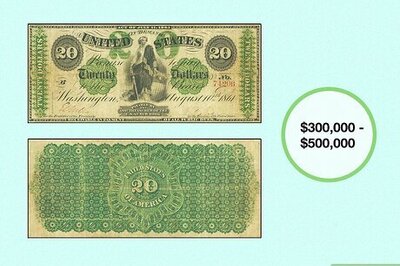

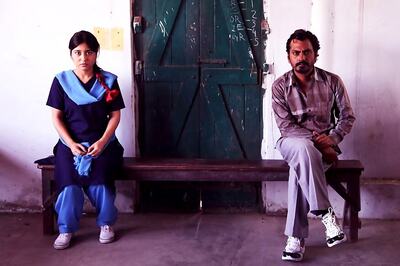

Comments
0 comment